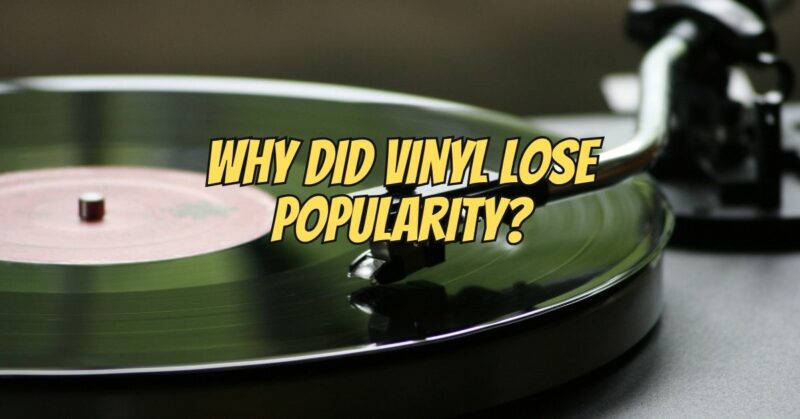The resurgence of vinyl records in recent years has been nothing short of remarkable. Music enthusiasts, both old and new, have embraced the format, and vinyl sales have experienced consistent growth. This rekindled interest in vinyl prompts a critical question: why did vinyl lose popularity in the first place? To understand the rise and fall of vinyl, we must delve into the history of recorded music, the impact of technological advancements, changing consumer preferences, and the eventual revival of this classic format.
The Golden Age of Vinyl
Vinyl records, often referred to as phonograph records, were the primary format for recorded music for most of the 20th century. They were introduced in the late 19th century and reached their peak of popularity during the mid-20th century. The vinyl era, often considered the “Golden Age of Vinyl,” lasted for several decades, from the 1950s to the 1980s. During this time, vinyl records were the dominant format for music consumption, and they played a central role in the music industry.
Several factors contributed to vinyl’s popularity during this era:
- Analog Warmth: Vinyl records are analog recordings, and their playback offers a warm, rich sound with a natural dynamic range. Many audiophiles and music purists favor the analog warmth of vinyl.
- Artistic Album Packaging: Vinyl’s large format allowed for impressive album art and packaging, making the album itself a piece of art. Album covers often featured elaborate designs, photographs, and liner notes.
- Collectibility: Vinyl records were often limited editions, and some became highly collectible. Limited pressings, colored vinyl, and unique cover art made vinyl appealing to collectors.
- Dominance of Record Stores: Record stores were key hubs of music culture, and vinyl records were the primary product they offered. These stores played a vital role in music discovery and community building.
- Nostalgia and Ritual: The physical act of selecting a record, placing it on a turntable, and gently lowering the stylus created a ritual that many music lovers cherished. Vinyl was often associated with nostalgia, evoking memories of music collections and record players.
The Decline of Vinyl
The decline of vinyl records began in the late 1970s and continued throughout the 1980s, primarily due to the emergence of new technologies and changing consumer preferences. Several key factors contributed to the decline of vinyl:
- Introduction of Cassette Tapes and CDs: The advent of cassette tapes and compact discs (CDs) introduced smaller, more portable formats with digital audio quality. This change in technology offered consumers greater convenience and durability.
- Portability and Durability: Cassettes and CDs were less fragile than vinyl records, making them suitable for car stereos, portable players, and compact storage. Vinyl records were relatively bulky and could be easily scratched or damaged.
- Digital Audio Quality: CDs, in particular, offered digital audio quality and superior sound clarity. The lack of surface noise, pops, and clicks made CDs more appealing to those who prioritized audio fidelity.
- Longer Playing Time: Vinyl records had limitations in terms of playing time per side. CDs allowed for longer albums without the need to flip or change sides.
- Decline of Record Stores: The decline of independent record stores, once the backbone of vinyl distribution, contributed to the format’s fall from grace.
The Revival of Vinyl
After vinyl’s decline and the rise of digital formats, the format remained a niche interest for collectors, audiophiles, and music purists. However, starting in the early 2000s, vinyl records began to experience a renaissance. Several factors have contributed to this resurgence:
- Audiophile Appeal: Audiophiles and music enthusiasts began to appreciate the analog warmth, dynamic range, and natural sound that vinyl provides. Many argued that vinyl offered a superior listening experience.
- Collectibility: The appeal of vinyl as a collectible format attracted new generations of music enthusiasts. Limited releases, special editions, and colored vinyl options added to the format’s allure.
- Tactile Experience: Vinyl records provide a unique tactile experience. Handling a record, setting the stylus, and carefully lowering it onto the turntable created a physical and sensory connection to the music.
- Nostalgia and Authenticity: Many music enthusiasts, including younger generations, developed an appreciation for the nostalgia and authenticity of vinyl. It was perceived as a link to music history and a rebellion against the digital age.
- Artist and Label Strategies: Artists and record labels strategically released their albums on vinyl to cater to collectors and audiophiles. This move rekindled interest in the format and generated revenue.
Conclusion
The rise and fall of vinyl records can be attributed to a complex interplay of factors, including technological advancements, changing consumer preferences, and the enduring appeal of analog music. Vinyl’s decline in the late 20th century was closely tied to the introduction of cassettes and CDs, which offered convenience, durability, and digital audio quality.
However, the revival of vinyl records in the 21st century demonstrated that the format never lost its intrinsic charm. Vinyl’s tactile experience, collectibility, and audiophile appeal, along with a renewed sense of nostalgia, drew a new generation of music enthusiasts back to vinyl.
While vinyl’s resurgence is a testament to the enduring appeal of analog music, it is unlikely to reach the same level of dominance it once enjoyed in the mid-20th century. Instead, vinyl occupies a unique niche in today’s diverse music landscape, coexisting with digital streaming and downloads, offering a sensory and nostalgic experience that has found a place in the hearts of music lovers across the globe.

